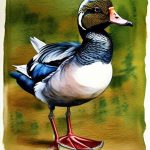Bali duck breeds are a group of domestic ducks that are native to the island of Bali in Indonesia. These ducks are known for their unique characteristics and have been bred for various purposes, including meat, eggs, and ornamental purposes. Bali duck breeds are popular among farmers and duck enthusiasts due to their adaptability to different environments and their ability to thrive in both free-range and confined settings. These ducks are also valued for their ability to forage for food and their resistance to diseases, making them a popular choice for small-scale farmers in Bali and beyond.
Bali duck breeds come in a variety of colors and patterns, with some breeds being more popular than others due to their distinct features and characteristics. These ducks are an important part of the agricultural landscape in Bali and play a significant role in the livelihoods of many farmers on the island. In this article, we will explore the characteristics, popular breeds, history, uses, and conservation efforts for Bali duck breeds, as well as discuss the future of these unique and valuable ducks.
Table of Contents
- 1 Characteristics of Bali Duck Breeds
- 2 Popular Bali Duck Breeds
- 3 History and Origin of Bali Duck Breeds
- 4 Uses of Bali Duck Breeds
- 5 Conservation Efforts for Bali Duck Breeds
- 6 Conclusion and Future of Bali Duck Breeds
- 7 FAQs
- 7.1 What are the characteristics of Bali duck breeds?
- 7.2 What is the origin of Bali duck breeds?
- 7.3 What is the purpose of breeding Bali duck breeds?
- 7.4 What are the advantages of raising Bali duck breeds?
- 7.5 What are the common health issues in Bali duck breeds?
- 7.6 What are the recommended housing and management practices for Bali duck breeds?
Key Takeaways
- Bali duck breeds are known for their unique characteristics and have a rich history and origin in Bali, Indonesia.
- These ducks are popular for their distinct physical features, such as their small size, colorful plumage, and ability to thrive in various environments.
- Some popular Bali duck breeds include the Balinese Crested Duck, Balinese Runner Duck, and Balinese White Duck.
- The history and origin of Bali duck breeds can be traced back to ancient times, where they were valued for their meat, eggs, and ornamental purposes.
- Conservation efforts for Bali duck breeds are crucial to ensure their survival and genetic diversity for future generations.
Characteristics of Bali Duck Breeds
Bali duck breeds are known for their medium to large size, with males typically weighing between 2.5 to 3.5 kilograms and females weighing between 2 to 3 kilograms. These ducks have a sturdy build with a broad chest, strong legs, and a slightly elongated body. Their plumage comes in a variety of colors, including white, black, brown, and combinations of these colors. Some popular breeds, such as the Balinese Crested Duck, are known for their distinctive crests on their heads, which add to their ornamental appeal.
In addition to their physical characteristics, Bali duck breeds are also known for their hardiness and adaptability. They are well-suited to the tropical climate of Bali and can thrive in both wetland and upland environments. Bali ducks are also good foragers and can feed on a variety of natural foods, including aquatic plants, insects, and small invertebrates. Their ability to thrive on natural forage makes them an economical choice for small-scale farmers who may not have access to commercial feed.
Popular Bali Duck Breeds
There are several popular breeds of Bali ducks that are prized for their unique characteristics and uses. One of the most well-known breeds is the Balinese Crested Duck, which is easily recognizable by the distinctive crest of feathers on its head. This breed is popular for ornamental purposes and is often kept for display in ponds and gardens due to its striking appearance. The Balinese Crested Duck is also valued for its meat and eggs, making it a versatile choice for farmers looking for a dual-purpose duck.
Another popular breed is the Balinese Runner Duck, which is known for its upright posture and distinctive running gait. This breed is valued for its ability to forage efficiently and its high egg production, making it a popular choice for farmers looking for a reliable source of eggs. The Balinese Runner Duck is also prized for its meat, which is lean and flavorful, making it a sought-after choice for culinary purposes.
Other popular breeds of Bali ducks include the Balinese White Duck, which is valued for its pure white plumage and gentle disposition, and the Balinese Black Duck, which is known for its striking black plumage and hardy nature. Each of these breeds has its own unique characteristics and uses, making them valuable assets to farmers and duck enthusiasts in Bali and beyond.
History and Origin of Bali Duck Breeds
The history of Bali duck breeds dates back centuries, with these ducks being an integral part of the agricultural landscape in Bali. It is believed that ducks were brought to Bali by early settlers from mainland Southeast Asia, where domestic duck farming has been practiced for thousands of years. Over time, these ducks were selectively bred by local farmers to develop breeds that were well-suited to the unique environment and agricultural practices of Bali.
The development of distinct Bali duck breeds was also influenced by the cultural and religious practices of the Balinese people. Ducks play an important role in Balinese Hindu rituals and ceremonies, and as a result, certain breeds were favored for their ornamental qualities and used in religious offerings and ceremonies. This cultural significance has contributed to the preservation and promotion of Bali duck breeds as an important part of Balinese heritage.
In recent years, efforts have been made to document and preserve the genetic diversity of Bali duck breeds through breeding programs and conservation initiatives. These efforts aim to ensure the long-term viability of these unique duck breeds and promote their sustainable use in agriculture and cultural practices.
Uses of Bali Duck Breeds
Bali duck breeds are valued for their versatility and are used for a variety of purposes in agriculture and everyday life. One of the primary uses of Bali duck breeds is for meat production. Ducks raised for meat are typically allowed to forage freely in rice fields or wetlands, where they can feed on natural vegetation and insects. This natural diet results in flavorful and tender meat that is prized in Balinese cuisine.
In addition to meat production, Bali duck breeds are also valued for their egg production. Ducks are prolific layers and can produce a large number of eggs throughout the year. Duck eggs are a popular ingredient in Balinese cooking and are used in a variety of dishes, including soups, stews, and desserts. Duck eggs are also valued for their nutritional content, being rich in protein, vitamins, and minerals.
Furthermore, some Bali duck breeds are kept for ornamental purposes due to their unique appearance and distinctive features. These ducks are often kept in ponds or gardens as a decorative element and are prized for their beauty and elegance. In addition to their ornamental value, these ducks may also be used in religious ceremonies and cultural events as part of Balinese Hindu traditions.
Conservation Efforts for Bali Duck Breeds

Conservation efforts for Bali duck breeds have gained momentum in recent years as awareness grows about the importance of preserving genetic diversity in domestic animal populations. Several organizations and government agencies in Indonesia have initiated programs aimed at documenting, conserving, and promoting the sustainable use of Bali duck breeds.
One such initiative is the establishment of breed registries and conservation centers dedicated to preserving rare and endangered duck breeds in Indonesia. These centers serve as repositories for genetic material from different duck breeds and provide technical support to farmers interested in raising purebred ducks. Additionally, these centers conduct research on breeding strategies, disease management, and nutrition to improve the overall health and productivity of Bali duck breeds.
Another important aspect of conservation efforts is raising awareness about the cultural significance of Bali duck breeds and promoting their value as part of Indonesia’s agricultural heritage. Educational programs and outreach activities are conducted to engage local communities in the conservation of traditional duck breeds and encourage sustainable farming practices that support genetic diversity.
Furthermore, efforts are being made to promote sustainable farming practices that integrate traditional duck farming with modern agricultural techniques. This includes promoting agroecological approaches that support biodiversity conservation while enhancing the productivity and resilience of small-scale farming systems.
Conclusion and Future of Bali Duck Breeds
In conclusion, Bali duck breeds are an important part of Indonesia’s agricultural heritage and play a significant role in the livelihoods of many farmers on the island of Bali. These ducks are valued for their versatility, adaptability, and cultural significance, making them an integral part of Balinese agriculture and traditions.
The future of Bali duck breeds depends on continued efforts to conserve genetic diversity, promote sustainable farming practices, and raise awareness about the value of traditional duck breeds. By supporting conservation initiatives, promoting sustainable use, and engaging local communities in the preservation of these unique ducks, we can ensure that future generations will continue to benefit from the rich cultural heritage and agricultural diversity represented by Bali duck breeds.
As we look ahead, it is important to recognize the importance of traditional knowledge and practices in maintaining genetic diversity and resilience in domestic animal populations. By integrating traditional wisdom with modern scientific approaches, we can create a future where Bali duck breeds thrive in harmony with nature while contributing to food security, cultural heritage, and sustainable livelihoods for farmers in Indonesia.
If you’re interested in learning more about Bali duck breeds, you might also want to check out this informative article on how many chickens you need for a family of 4. Understanding the dynamics of poultry farming and the different breeds can be essential for anyone looking to start their own backyard flock.
FAQs
What are the characteristics of Bali duck breeds?
Bali duck breeds are known for their small to medium size, with a distinctive upright stance and a slender neck. They have a unique color pattern with a white body and black markings on the head and neck.
What is the origin of Bali duck breeds?
Bali duck breeds originated from the island of Bali in Indonesia. They have been bred for centuries by the local farmers for their meat and eggs.
What is the purpose of breeding Bali duck breeds?
Bali duck breeds are primarily bred for their meat and eggs. They are also raised for their ornamental value and as pets due to their unique appearance.
What are the advantages of raising Bali duck breeds?
Raising Bali duck breeds can be advantageous as they are known for their hardiness, adaptability to various climates, and good foraging abilities. They are also relatively low maintenance and can thrive in free-range or semi-intensive farming systems.
What are the common health issues in Bali duck breeds?
Bali duck breeds are generally hardy and resistant to many common poultry diseases. However, they may be susceptible to respiratory infections and parasitic infestations if not provided with proper care and management.
What are the recommended housing and management practices for Bali duck breeds?
Bali duck breeds require a secure and predator-proof housing with access to clean water for swimming and foraging. They also benefit from a balanced diet, regular health checks, and proper vaccination and deworming schedules.
Meet Walter, the feathered-friend fanatic of Florida! Nestled in the sunshine state, Walter struts through life with his feathered companions, clucking his way to happiness. With a coop that’s fancier than a five-star hotel, he’s the Don Juan of the chicken world. When he’s not teaching his hens to do the cha-cha, you’ll find him in a heated debate with his prized rooster, Sir Clucks-a-Lot. Walter’s poultry passion is no yolk; he’s the sunny-side-up guy you never knew you needed in your flock of friends!







